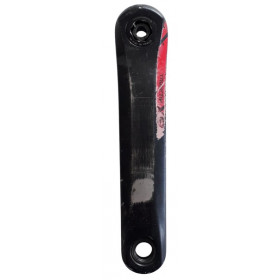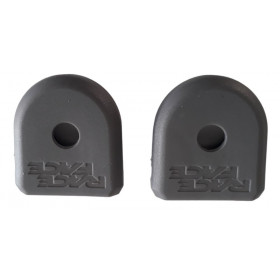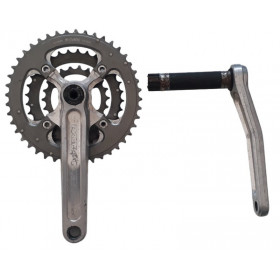-
 UsedRace Face Prodigy crank triple 175 mm
UsedRace Face Prodigy crank triple 175 mm- €8.99
-
 New product -60%FSA V-Drive crankset triple 175 mm
New product -60%FSA V-Drive crankset triple 175 mm- €56.40
- €140.99
-
 UsedShimano SLX FC-M580 crankset
UsedShimano SLX FC-M580 crankset- €32.99
-
 New productSingle chainring 32-tooth crankset
New productSingle chainring 32-tooth crankset- €55.99
-
 UsedSram Truvativ X9 crank
UsedSram Truvativ X9 crank- €18.99
-
 UsedSram NX Eagle crankset 12s 175 mm used
UsedSram NX Eagle crankset 12s 175 mm used- €48.99
-
 New product -40%Sram NX Eagle crankset 12s 175 mm
New product -40%Sram NX Eagle crankset 12s 175 mm- €77.99
- €129.99
-
 New product -60%Carbon cranks boot Race Face Sram Shimano grey
New product -60%Carbon cranks boot Race Face Sram Shimano grey- €6.00
- €14.99
-
 UsedRace Face Deus XC crankset 175 mm triple
UsedRace Face Deus XC crankset 175 mm triple- €24.99
-
 More detailsUsed Out-of-StockSram GXP MTB crankset
More detailsUsed Out-of-StockSram GXP MTB crankset- €28.99
Showing 1-10 of 10 item(s)
Everything you need to know about the mountain bike crankset: the heart of your mountain bike's drivetrain
When we talk about mountain bike performance, we often think of tires, suspension, and brakes. But one central component is sometimes underestimated: the mountain bike crankset. A true mechanical engine, it's at the heart of the mountain bike drivetrain and plays a vital role in pedaling efficiency, torque management, and terrain adaptation. Let's take a closer look at its features, specifics, and why choosing a good Shimano mountain bike crankset can make all the difference.
What is a mountain bike crankset ? Deciphering an essential component
The mountain bike crankset is one of the central elements of a mountain bike's drivetrain. Placed between the two pedals, it converts the cyclist's muscular energy into rotational motion, which is then transmitted to the mountain bike chain, then to the cassette, and finally to the rear wheel via the mountain bike derailleur. In other words, it's the starting point of movement on your mountain bike: without a crankset, there's no propulsion.
The components of a mountain bike crankset:
A bicycle crankset isn't just two arms and a chainring. It's a technical system designed to withstand the constraints of the terrain, optimize pedaling, and adapt to the cyclist's needs. It includes:
- Two crank arms (left and right): these connect the pedals to the bottom bracket axle. Their length (generally between 165 mm and 175 mm) directly influences cadence and pedaling power.
- One or more mountain bike chainrings: these are the cogs that engage the chain. The choice of the number of chainrings (single, double, or triple) depends on the rider's riding style and level.
- A spindle: passing through the bottom bracket, it connects the two crank arms. Modern systems like Shimano's Hollowtech II integrate this spindle into the right crank arm for increased rigidity and lightness.
- Mountain bike pedals: these attach to the end of the cranks. Whether flat or automatic, they allow the cyclist to efficiently transmit their pedaling force.
The role of the crankset in the mountain bike drivetrain
The mountain bike crankset is the starting point of the entire mountain bike drivetrain. With each pedal revolution, the chainring(s) drive the mountain bike chain, which transfers the motion to the cassette. The latter, via the rear derailleur, transmits the rotation to the freewheel that propels the bike.
A well-chosen and well-maintained crankset allows for:
- Better responsiveness when accelerating or climbing
- A smoother drivetrain, especially on technical terrain
- Better adaptation to your cadence and power
In short, the crankset acts like the conductor of the propulsion mechanism. Each component—mountain bike chainring, chain, derailleur, pedals—must work in harmony to ensure efficient, smooth, and safe pedaling.
The different MTB crankset configurations: which one to choose for which riding style ?
The MTB crankset comes in several configurations, each adapted to a specific riding style and rider profile. Single, double, or triple chainrings: each system has its advantages and limitations, and meets specific MTB drivetrain needs.
Single chainring (1x): modern simplicity
The single chainring configuration—often referred to as "1x" (one chainring at the front)—has become the standard on modern mountain bikes, particularly for technical and sporty disciplines.
Advantages:
- Ease of use: a single lever for rear gear changes, ideal for staying focused on riding.
- Weight savings: no front derailleur or additional controls.
- Less maintenance: fewer parts, therefore less risk of malfunction.
- Silent and reliable drivetrain, even on rough terrain.
Disadvantage:
Less gear range compared to multi-chainring setups, although this is largely offset by wide-range cassettes (e.g., 10-50, 11-51, etc.).
Ideal for:
Enduro mountain biking, cross-country (XC), trail riding, or e-mountain biking. This is the most common setup today on new bikes, from mid- to high-end.
Double chainring (2x): the balance between versatility and performance
The double chainring crankset remains an excellent compromise for mountain bikers looking for versatility, particularly for sport touring, all-mountain biking, or long rides with varying elevation.
Advantages:
- Wide range of gears: more gears allow you to tackle both steep slopes and long, rolling sections.
- Better cadence management, especially in the mountains or on mixed terrain.
Disadvantages:
- Increased weight and complexity: adding a front derailleur and additional controls.
- Higher risk of derailment than a single chainring, especially on very uneven terrain.
Ideal for:
Cyclists who practice mountain biking, long distances, or who want to maintain a wide range of gears without switching to a single drivetrain.
Triple chainring (3x): "old-school" versatility
The triple chainring crankset (often 22/32/42 teeth) was once standard on most mountain bikes. Today, it is tending to disappear in favor of simpler, more efficient systems.
Advantages:
- Very wide gear range, perfect for beginners or casual cyclists.
- Easier climbing, thanks to a very "smooth" small chainring.
Disadvantages:
- Heavier and more complex system
- Less smooth transmission on technical terrain
- Less compatible with modern drivetrains (particularly Shimano 12-speed or SRAM Eagle)
Ideal for:
Recreational mountain biking, off-road trekking, or cyclists who prioritize comfort over performance. Still used on some entry-level mountain bikes or touring bikes.
Choosing the right configuration for your mountain bike crankset
| Configuration | Benefits | Disadvantages | Recommended practice |
|---|---|---|---|
| Single tray (1x) | Light, simple, reliable | Fewer reports availables | XC, enduro, trail, mountain bike |
| Double tray (2x) | Versatile, wide speed range | More complex | All-mountain, sport hiking |
| Triple tray (3x) | Very versatile, easy uphill | Heavy, obsolete | Leisure mountain biking, trekking |
Choosing the right mountain bike crankset is no small feat. It directly impacts your pedaling comfort, your climbing and descending abilities, and your overall efficiency on the trails. Also consider adjusting the rest of your drivetrain (derailleur, cassette, mountain bike chain) for perfect compatibility.
Why choose a Shimano MTB crankset ? Reliability, performance, and compatibility
In the MTB crankset market, it's hard to ignore Shimano. For decades, the Japanese brand has established itself as a key player in the world of mountain biking, particularly in the field of mountain bike drivetrains. Robust, precise, and built to last, Shimano MTB cranksets offer an ideal compromise between performance, reliability, and affordability.
Perfect compatibility with Shimano drivetrains
One of the major advantages of a Shimano MTB crankset is its complete integration with the brand's ecosystem. It works in perfect harmony with:
- Shimano Hyperglide+ MTB chains: smooth shifting, even under load.
- Shadow RD+ rear derailleurs: optimal chain retention on uneven terrain.
- Shimano cassettes: optimized gear range for all terrains.
- Shimano Hollowtech II bottom brackets: easy assembly, increased rigidity.
This compatibility between all components guarantees a quiet, precise, and smooth drivetrain, essential for climbing, descending, or in technical sections.
A robust design, proven on all terrains
Whether it's an entry-level Shimano MTB crankset or a highly technical model, the manufacturing quality remains consistent:
- Strong and durable materials: aluminum alloy or reinforced composite depending on the range.
- Hollowtech II technology: integrated axle and hollow cranks for an excellent weight/stiffness ratio.
- Rugged reliability: even in mud, sand, or under heavy loads.
Shimano cranksets are designed to withstand impacts, jumps, sudden gear changes, and the many kilometers that pass without fail.
Ranges adapted to all levels and all practices
Whether you're a beginner, a regular mountain biker, or a competitor, there's a Shimano MTB crankset to suit your needs:
Shimano Deore (FC-M6100 / M5100)
- 1x12 or 2x11-speed drivetrain
- Ideal for occasional to regular riders
- Excellent value for money
- Gradual upgrade from older groupsets
Shimano SLX (FC-M7100)
- Lightweight and stiff crankset, designed for sport mountain biking
- Technology derived from the top-of-the-range Shimano XT
- Available with single or double chainrings
- Perfect for trail, all-mountain, or amateur enduro
Shimano XT (FC-M8100) / XTR (FC-M9100)
- Designed for competition and outdoor riding committed
- Ultralight, extremely rigid
- Extensive compatibility with 12-speed cassettes and Hyperglide+ chains
- Premium finish, exceptional durability
Why choose a Shimano mountain bike crankset ?
| Asset | Detail |
|---|---|
| Recognized reliability | Components designed to last, even in extreme conditions |
| Perfect compatibility | Optimal integration with the entire Shimano transmission |
| Proven technology | Hollowtech II, Hyperglide+, Shadow RD+ |
| Choice for all budgets | Deore, SLX, XT, XTR: a complete range for everyone |
| Easy maintenance | Standardized parts, availability of components, ease of assembly |
The Shimano mountain bike crankset is a strategic choice for any cyclist looking for a smooth, reliable, and high-performance drivetrain. Whether you're upgrading a mountain bike or looking to upgrade your existing drivetrain, choosing Shimano means relying on the peace of mind, performance, and expertise of a leading brand.
Discover our new and used Shimano mountain bike cranksets, selected for their quality, compatibility, and competitive prices.
Criteria to consider before buying a mountain bike crankset
Choosing the right mountain bike crankset isn't just about choosing an attractive or affordable model. It's a central component of your mountain bike drivetrain, interacting directly with your chain, cassette, derailleur, and even your pedals. To pedal efficiently, without losing energy or derailing, several technical criteria must be considered. Here are the essential points to check before purchasing a bike crankset suited to your riding style.
1. Crank arm length: cadence, power, and comfort
Crank arms are the arms of the crankset to which the pedals are attached. Their length, generally between 165 mm and 175 mm, influences your pedaling style.
- 165 mm: promotes a high cadence, ideal for smaller riders or cross-country riding.
- 170 mm: standard size, a good compromise for most riders.
- 175 mm: suitable for taller people or those looking for more leverage when climbing.
A good length allows for better biomechanical efficiency, limits fatigue, and improves the overall performance of your mountain bike drivetrain.
2. The number of teeth on the chainring: speed or convenience ?
The mountain bike chainring, attached to the crankset, is a cogwheel that drives the mountain bike chain. Its number of teeth determines the gear ratio.
- Small chainring (28 to 32 teeth): facilitates technical climbs, used for enduro or e-MTB.
- Medium chainring (32 to 34 teeth): a good compromise for varied routes.
- Large chainring (36 to 38 teeth and more): prioritizes speed on smooth terrain, suitable for fast cross-country riding.
The right chainring should be chosen based on the terrain, your fitness, and the type of cassette you use.
3. Drivetrain compatibility: a coherent system
A mountain bike crankset doesn't work alone. It must be perfectly compatible with the other components of your bike drivetrain:
- Mountain bike chain: suitable width (10, 11, 12 speeds), Hyperglide+ or Eagle technology.
- Cassette: gear ratio and number of gears compatible with the chosen chainring.
- Mountain bike derailleur: chain management capabilities (length, tension, gear range).
An incompatible crankset can cause chain slippage, missed shifts, or premature drivetrain wear.
4. Axle type: stiffness, weight, and frame compatibility
The bottom bracket axle is the part that connects the two crank arms by passing through the frame's bottom bracket. There are several standards:
Square taper axle
- Old standard, still found on entry-level mountain bikes.
- Simple to install but less rigid and heavier.
Integrated Axle (Hollowtech II – Shimano)
- Hollow steel or aluminum axle, integrated into the right crank arm.
- Very common, lightweight, stiff, and easy to maintain.
- Used on most modern Shimano MTB cranksets (Deore, SLX, XT, etc.).
DUB Axle (SRAM)
- Single diameter (28.99 mm), designed to simplify compatibility with different frames.
- Very rigid and efficient, especially under intensive use.
- It is essential to check the compatibility between the crankset, axle and bottom bracket of your frame.
Checklist before buying a mountain bike crankset
| Criteria | What you need to know |
|---|---|
| Crank length | 165 to 175 mm depending on your height and practice |
| Number of teeth | Chainring of 28 to 38 teeth depending on the terrain |
| Transmission compatibility | Chain, cassette, derailleur adapted to the crankset |
| Axis type | Square (basic), Hollowtech II (Shimano), DUB (SRAM) |
A well-chosen Shimano MTB crankset, compatible with your groupset and suited to your riding style, allows you to optimize every pedal stroke. It's a strategic investment for improved fluidity, performance, and comfort, whether you're riding cross-country, all-mountain, or an e-MTB.
When should you replace your mountain bike crankset ? The telltale signs
The mountain bike crankset is one of the most stressed mechanical components of your bike. Each pedal stroke exerts pressure on the axle, cranks, chainrings, and chain. Over time, wear naturally sets in, affecting the quality of your drivetrain. Knowing how to recognize the signs of fatigue helps prevent breakage, reduced performance, or premature wear of other components such as the mountain bike derailleur or cassette.
Symptoms of a worn MTB crankset
Here are the main signs that it's time to consider replacing your crankset:
1. Play in the crankset axle
If you feel lateral or vertical play when pushing on the pedals or turning the cranks by hand, this may indicate:
- Wear of the crankset axle or bottom bracket.
- Wear or loose bearings.
- This play reduces pedaling efficiency and can lead to uneven wear of the MTB chain.
2. Worn, broken, or bent chainring teeth
The teeth of your MTB chainrings should be clean, even, and symmetrical. If they are:
- Sharp, hooked, or uneven,
- Bent or broken,
...this is a clear sign of wear. This causes the chain to skip, poor grip, and makes smooth shifting difficult.
3. Persistent noises (squeaking, creaking)
Recurring squeaking, even after cleaning and lubrication, may indicate:
- Insufficient tightening,
- A damaged or deformed axle,
- Bearings in the bottom bracket are nearing the end of their life.
These noises are unpleasant, but they also indicate a loss of alignment that disrupts the entire drivetrain.
4. Difficulty shifting
If your mountain bike chain has difficulty moving up or down between the sprockets, despite a properly adjusted derailleur, the problem may be due to:
- Wear on the chainrings,
- A misaligned crankset,
- Or a general misalignment of the crankset and bottom bracket.
This phenomenon becomes even more noticeable when climbing or during high-stress riding (technical mountain biking, enduro, etc.).
Why replace your Shimano mountain bike crankset ?
A well-maintained Shimano mountain bike crankset can last for several seasons. But when it shows signs of wear, replacing it offers many advantages:
- Restores smooth and precise shifting
- Perfect compatibility with a new Shimano Hyperglide+ mountain bike chain
- Improves stiffness and pedaling efficiency
- Prolongs the lifespan of other components (cassette, pulleys, mountain bike chainring)
Changing the crankset is often the ideal opportunity to replace the chain and, if necessary, the chainrings at the same time. This ensures optimal operation of the entire mountain bike drivetrain.
When to replace or repair? The right timing
| Condition of the crankset | Recommended action |
|---|---|
| Slight tooth wear | Replacement of the tray(s) only |
| Game in the axis | Checking the case, or even replacing it completely |
| Crooked teeth or broken teeth | Immediate change of the affected tray |
| Squeaking despite cleaning | Replacing the crankset or bearings |
| Difficulty shifting gears | Complete transmission check: shifters, derailleurs, chain, cassette, often coupled with a replacement of the crankset |
Prevention is better than repair
Changing your bike crankset at the right time helps maintain the proper functioning of your entire drivetrain. A new, properly assembled Shimano MTB crankset, paired with a new chain and a properly adjusted derailleur, will give your bike a boost, especially after several demanding seasons.
In summary
The mountain bike crankset isn't just another component: it's a strategic link in your mountain bike's chainring. Choosing a reliable, well-designed model suited to your riding style, like a Shimano mountain bike crankset, guarantees smooth, efficient rides without any unpleasant mechanical surprises.
Discover our online store:
Our new and used Shimano cranksets, chainrings, pedals, chains, and components, carefully selected to meet the needs of all mountain bikers, from recreational to competitive.
